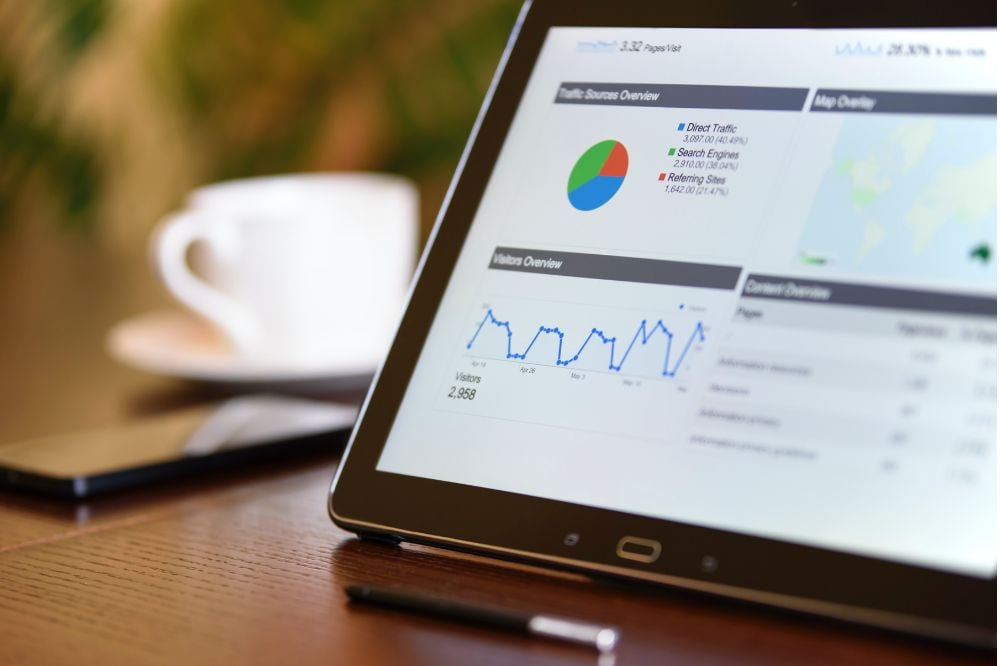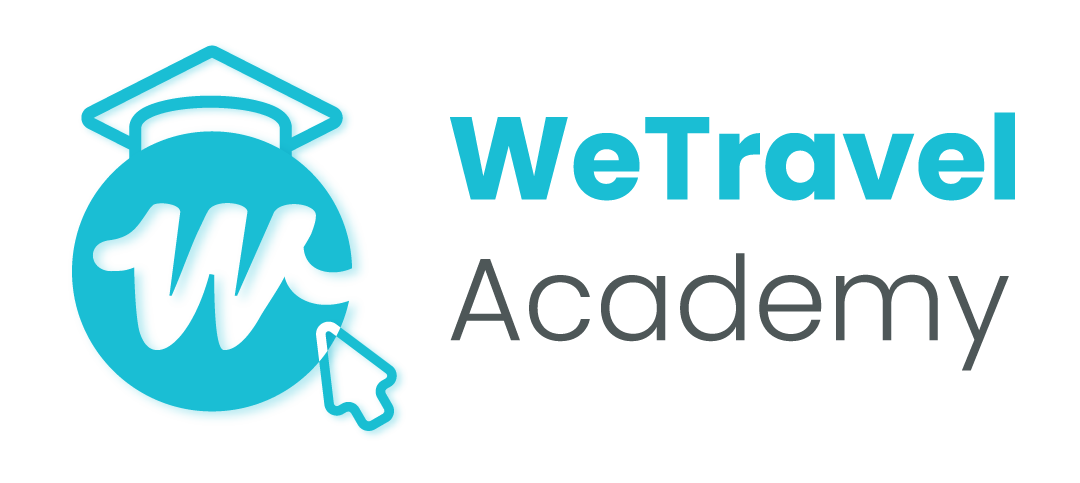Welcome to the world of Google Analytics 4 (GA4), where you have access to exceptional data insights that can help you better understand the customer journey.
Google Analytics (GA) is one of the most valuable tools available for helping you measure traffic and engagement, analyze data, and monitor your travel brand’s performance online.
This can help you understand how your audience is behaving, how your website is performing, and how you can optimize marketing efforts for better results.
In this guide, we will explore some of the key features of GA4 for travel businesses and break down how you can use them to boost your marketing and brand management efforts.

What’s The Difference Between Universal Analytics And Google Analytics 4?
GA4 is the latest version of Google Analytics. While it still offers all of the same kind of functions as you get from Universal Analytics, the platform does differ slightly in how it collects and uses data.
Let’s break down some of the main differences between these two platforms.
Data Collection And Use
The most significant difference between GA4 and Universal Analytics is the data model each platform uses. Universal Analytics uses a tracking model based on sessions and pageviews. However, GA4 uses an event-based model. This means GA4 measures every interaction on a website or app as an event.
This will help travel businesses access stronger ‘user’ metrics and dimensions for greater insights into their audience. You can also use GA4 to make more detailed reports and get a more holistic overview of the customer journey with your brand.
Tracking Methods
Tracking in Universal Analytics is mainly based on cookies. However, with cookies being removed, this tracking method is no longer as useful to businesses.
GA4 uses a combination of cookies and user-centric identifiers like Google Signals and Firebase Instance IDs, to track users' behavior across different devices and platforms. This provides more accurate tracking functions to help you understand your customers more deeply.
Universal Analytics also focuses on web tracking, while GA4 provides both web and app tracking. This means the platform gathers data from a greater range of courses, providing a more unified view of the user journey across different platforms.

Improved Measurement
GA4 offers more advanced measurement abilities compared to Universal Analytics. This is because measurement includes automatic tracking of more events and interactions, like scroll tracking, file downloads, outbound clicks, and video engagement.
As a travel business, you can use these features to gain greater insights into the customer journey and how visitors interact with your business online.
Reporting
The GA4 reporting interface is slightly different from Universal Analytics. With GA4, there’s more focus on user behavior and engagement across multiple touchpoints. You can also access new reports, such as a user lifetime report, a user engagement report, and a funnel analysis report.
Again, this provides deeper insights into user journeys to help your travel business improve acquisition and customer retention.
AI And Automation
As a next-level analytics platform, GA4 offers more advanced features powered by AI and automation. This includes features like automated insights, predictive analytics, and anomaly detection.
Travel businesses can use these features to gain greater insights with less effort, and draw more actionable insights from their data.
Data Control
The world has become increasingly concerned about data security and privacy. GA4 acknowledges this by providing users with more options to manage data collection.
The platform also aligns with privacy regulations like the General Data Protection Regulation (GDPR) and provides features like data deletion - if users request it.
Why Google Analytics For Travel Businesses Is Important
Google Analytics is one of the most valuable free tools that any travel business can and should use. Here are some of the main reasons why Google Analytics is so useful and important.

Tracking Website Traffic
The most common use case of Google Analytics is to allow businesses to track website traffic and gain insights into their visitors’ behavior.
Google Analytics allows tour companies to access valuable data on the number of users that visit the website, where they are based, referral sources for reaching their travel website, and what types of devices they use.
This information can help your tour business understand its audience better to make more informed decisions about its website performance.
Performance Analytics
Travel businesses can use Google Analytics to analyze how their website, landing pages, and marketing efforts are performing.
With metrics like bounce rate, average session duration, and conversion rates easily available, Google Analytics is a valuable source for understanding the intricacies of how your business is performing online. This can help you understand what’s working, and identify areas for improvement,
Analyzing this data helps travel businesses optimize their online presence, improve the customer journey, and ultimately, increase conversions.
Tracking Goals
This tool also offers an effective solution for establishing and tracking goals.
For example, your business could set goals around newsletter sign-ups or booking completions. You can use Google Analytics to track these goals to understand how well your campaigns are performing and where you can improve them.
You can also identify which of your marketing channels are driving the most conversions. This can help your travel business make smarter decisions around allocating budget, time, and effort.

Sales Funnel Analysis
A classic travel sales funnel may be a bit complex at times, with the different steps that a customer goes through before making a booking.
Travel businesses can use Google Analytics to better understand how the different stages of their funnel are performing and to identify possible drop-off points. This can help you optimize certain areas to improve conversion rates.
Sales Tracking
Travel operators can use Google Analytics to track transactions, revenue, and product performance.
This helps to comprehend how effective your travel booking process is and what your most profitable offerings are. By digging into this data, tour companies can enhance their pricing strategies and identify cross-sell and upsell opportunities.
Monitoring Paid Campaigns
If your travel business runs any paid advertising campaigns, then you can use Google Analytics to easily track the performance of those campaigns.
This helps you understand your ROI and identify strategies that work best for your business. This is essential for making data-driven decisions that boost your travel marketing performance.
Access Customized Insights
The platform lets you generate custom insights and reports to help you understand the specific performance of your company. This means that you can create custom segments and set your own parameters for discovering specific data.
When used properly, all of these insights can help travel businesses make more informed decisions, understand their audience better, and improve customer satisfaction.

How To Use Google Analytics 4 For Travel Marketing
GA4 includes a range of sections that offer various types of data insights. Each section offers unique insights to help your travel company better understand its target audience, and marketing efforts, and find ways to optimize your campaigns.
Here are some of the main sections in GA4 and how you can use Google Analytics for optimal success.
Home Section
The Home section in Google Analytics provides a high-level overview of your website or app performance. It showcases information pertaining to your behavior in analytics.
You can also access automated insights and recommendations from the Home section to better understand your data, monitor traffic and navigate around analytics.
This section displays where people come from when they visit your website, what country they’re based in, and what device they’re using. You can also access valuable page speed insights to help you improve your website’s technical performance.
Real-Time Section
This section shows you how many people are on your website or app in real time. You can see which pages your website visitors are on, where they are viewing from, and what traffic sources brought them to your website.
You can set it to see per-second views or base it on time periods (look at the views within the last 30 minutes etc).
If you’re running any live campaigns or events, then this is a valuable section to reference.

Analysis Hub
The Analysis Hub is one of the most important features of Google Analytics 4. This powerful section lets you explore and analyze your data on a deeper level. You can use it to access various reports and data analysis techniques.
This includes elements like path analysis or funnel analysis to better understand how your audience is interacting with your travel business online. You can also create custom reports and apply specific filters to help you get exact insights into your user behavior.
Acquisition Section
Acquisition in Google Analytics 4 shows you how users are entering your website or app. This covers the traffic source that brought them to your brand - like organic traffic, social media, referrals, or paid advertising.
Understanding acquisition helps you comprehend what campaigns are most effective at driving traffic, and which pages are performing the best in terms of different acquisition approaches.
Engagement Section
Engagement on Google Analytics 4 reveals how users are interacting with your website or app. This section covers metrics like session duration, screen views, bounce rate, and event tracking.
These are some of the most important metrics to help you optimize website performance and improve retention and engagement. You can monitor engagement patterns across your website and app to help you enhance the user experience.
Monetization Report
The monetization report in Google Analytics 4 is useful for travel businesses wanting to keep an eye on their bookings and revenue. This report tracks any revenue-related metrics on your website, like average order value, purchase events, and conversion rates.

You can use the monetization report to understand what kind of financial impact your marketing efforts are resulting in. This can help you optimize your revenue generation and pricing strategies to boost ROI.
Retention Overview Report
Understanding user retention and churn rates is essential for any tour operator. This section on Google Analytics 4 helps you analyze how frequently users return to your website. You can view retention patterns over specific time frames, and understand what pages on your site offer greater retention rates.
This is important for improving customer loyalty and engagement.
User Explorer Section
The user explorer section allows you to get granular with data and access individual insights into each user's behavior.
You can choose a specific user and look into their interactions with your brand, conversion paths, events, session durations, and more. This is useful for understanding user journeys and providing personalized marketing efforts.
Configuration Section
This is where you can customize and manage your Google Analytics 4 property settings.
You can access the configuration settings to set up goals, custom dimensions and metrics, create an audience, import data, and more. You can also integrate other Google products into this section, like Google Ads.
Glossary of GA Terms
Here are some essential terms to be acquainted with on this platform. It will help you to understand how to use Google Analytics and what all the different sections and actions mean:
Acquisition
This refers to the various channels and avenues that draw people to your site.
Audience Measurements
An overview of the size and composition of the audience that visits your website
Active Users
The number of engaged users currently on your website.
Attribution
Attribution is a way to control how the credit to conversion is provided to the specific channel that brought about the conversion.

Audience
You can create defined audience segments based on the specific factors that you choose. For example, this could include existing customers who have landed on your site from a social media campaign you've been running.
Connected Site Tags
These are used to link new properties to Google Analytics installed in the global site tag (gtag.js) without modifying the tag.
CPC
Cost per click refers to how much you spend on specific user clicks. Typically this refers to paid ads.
Data Retention
Data retention displays how long certain user data is available in Google Analytics.
Dimension
A specific attribute of your website visitors and what particular interactions they had with your website.
Engaged Sessions
Sessions on your website that last longer than 10 seconds.
Engagement Rate
The number of engaged sessions is divided by the number of total sessions.
Events Per Session
The average number of events that happen per session on your website.
Google Ads
Google’s paid advertising platform, which you can connect to Google Analytics and monitor what impact this has on your site.
New User
Any website visitors who have visited your site for the first time within a specific date range.
Organic Channels
Sources that your acquisitions come from are not from paid promotions and ads.
Paid channels
Sources that your acquisitions come from are not organic but paid ads and promotions.
Page Views
Each time a visitor to your website views a page.

Segment
Segments provide insights into specific sections of your website traffic based on users, events, and sessions.
Sessions
Sessions refer to the actual visit to your site, not the user.
Users
The person who is visiting your site.
Conclusion
Using Google Analytics for travel businesses is essential. It helps you understand how people interact with your brand online and how your online presence performs.
This is all possible through many different data insights that you can access with the game-changing platform.
The better you understand Google Analytics, the more you can optimize your online presence. This means everything your business does, from publishing content to running ads, can be enhanced for optimal performance.
New resources, straight to your inbox
We’re committed to your privacy. WeTravel uses the information you provide to us to contact you about our relevant content, products, and services. You may unsubscribe at any time.




